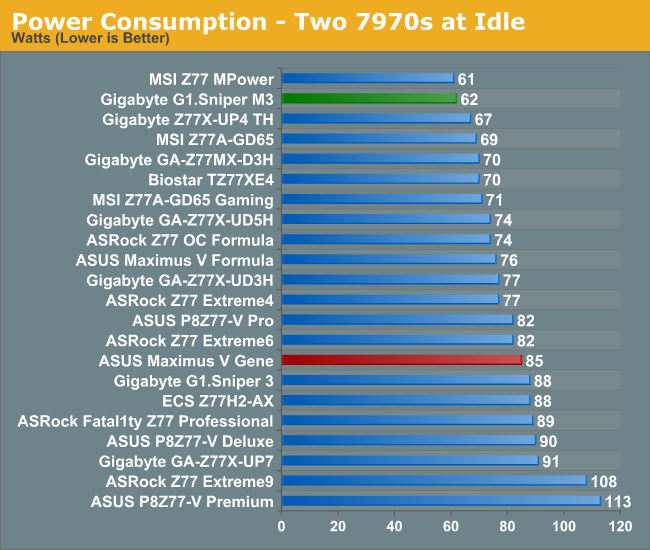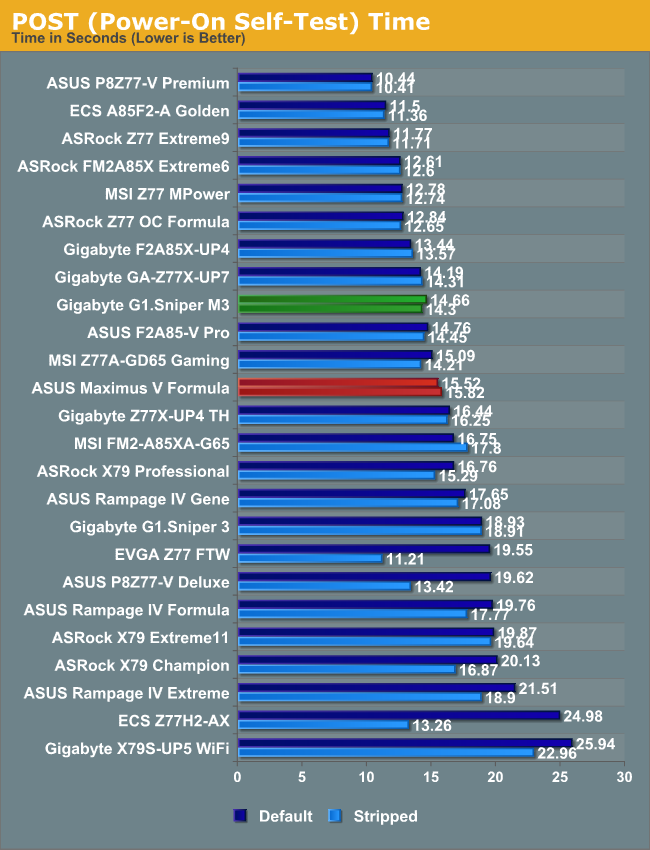ASUS Maximus V Gene vs. Gigabyte G1.Sniper M3 Review
by Ian Cutress on May 13, 2013 10:00 AM EST- Posted in
- Motherboards
- Gigabyte
- Asus
- MicroATX
- Z77
Many thanks to...
We must thank the following companies for kindly providing hardware for our test bed:
Thank you to OCZ for providing us with 1250W Gold Power Supplies.
Thank you to G.Skill for providing us with the memory kits.
Thank you to ASUS for providing us with the AMD GPUs and some IO Testing kit.
Thank you to ECS for providing us with the NVIDIA GPUs.
Thank you to Corsair for providing us with the Corsair H80i CLC.
Thank you to Rosewill for providing us with the 500W Platinum Power Supply for mITX testing, BlackHawk Ultra, and 1600W Hercules PSU for extreme dual CPU + quad GPU testing, and RK-9100 keyboards.
Software and BIOS
Normally as part of a review we would examine the Software and BIOS of each motherboard. Both the ASUS and Gigabyte boards have bigger brothers, wherein we tested and analyzed the offerings from both manufacturers. Please click to link through to the ASUS ROG MVF Software and BIOS analysis, or the Gigabyte G1.Sniper 3 Software and BIOS analysis.
Test Setup
Power Consumption
Power consumption was tested on the system as a whole with a wall meter connected to the OCZ 1250W power supply, while in a dual 7970 GPU configuration. This power supply is Gold rated, and as I am in the UK on a 230-240 V supply, leads to ~75% efficiency > 50W, and 90%+ efficiency at 250W, which is suitable for both idle and multi-GPU loading. This method of power reading allows us to compare the power management of the UEFI and the board to supply components with power under load, and includes typical PSU losses due to efficiency. These are the real world values that consumers may expect from a typical system (minus the monitor) using this motherboard.
While this method for power measurement may not be ideal, and you feel these numbers are not representative due to the high wattage power supply being used (we use the same PSU to remain consistent over a series of reviews, and the fact that some boards on our test bed get tested with three or four high powered GPUs), the important point to take away is the relationship between the numbers. These boards are all under the same conditions, and thus the differences between them should be easy to spot.

One would expect power consumption of smaller motherboards to be less than that of full sized ATX ones – in the case of the Sniper M3 at idle that is true, but when it is loaded with two GPUs during Metro2033, it matches some of the high end ATX models, and moreso than the full G1.Sniper 3. This could perhaps be related to the audio solution.
POST Time
Different motherboards have different POST sequences before an operating system is initialized. A lot of this is dependent on the board itself, and POST boot time is determined by the controllers on board (and the sequence of how those extras are organized). As part of our testing, we are now going to look at the POST Boot Time - this is the time from pressing the ON button on the computer to when Windows starts loading. (We discount Windows loading as it is highly variable given Windows specific features.) These results are subject to human error, so please allow +/- 1 second in these results.

Neither motherboard is able to hit a glorious 12 seconds for Windows 7 POST times with two GPUs installed.










31 Comments
View All Comments
Termie - Monday, May 13, 2013 - link
Ian - thanks for another enthusiast-class review!I've had the MVG since last summer and absolutely love it. But you give it too much credit in one regard - it doesn't have built-in wireless. I did a double-take when I saw you mention that not once, but twice, and went straight to the Asus website: http://www.asus.com/ROG_ROG/MAXIMUS_V_GENE/#specif...
I even read the instruction manual, and sure enough it says the wireless card is sold separately. So, unless it's been updated recently, the wireless mPCIe card does not come with the MVG.
IanCutress - Monday, May 13, 2013 - link
Thanks, though it seems I had a complete brain fart on my end. Up until this point I had always assumed that any ASUS board with an mPCIe Combo Card comes with the WiFi module - the giveaway should have been the lack of WiFi antenna in the box. Typically there's no need for me to install the mPCIe card for every motherboard I test (and I clearly didn't here), though it will become necessary when I've finished updating our WiFi testing scenario. That is a bit disappointing to not come with the WiFi card, though I still stand by my recommendation.Ian
Termie - Monday, May 13, 2013 - link
By the way, two minor typos. On the gaming page, you say "rather ubiquitous to lane counts", but I think you mean ambivalent. Also, the POST graph refers to the MVG as the Maximus V Formula.Great job overall - you're really able to dig deep to illustrate the fairly significant differences between motherboards.
lmcd - Monday, May 13, 2013 - link
On the wireless card -- is it mPCI-e AND mSATA, or mPCI-e OR mSATA?As in, are there places for two expansions there? I'm guessing no but hoping otherwise...
philipma1957 - Monday, May 13, 2013 - link
just one or the other I own both of these boards. I use the mSata on the asus as my boot driveDalekDoc - Monday, May 13, 2013 - link
I thought the PCIe layout on the G1.Sniper M3 made sense. This is the only matx board I've seen in which you can dual-gpu + sound card/other add-on PCIe card.The layout on the Gene and most other matx boards means you're blocking the 4rd PCIe if you go dual gpu as most gpus are dual slot nowadays..
philipma1957 - Monday, May 13, 2013 - link
the gigabyte is far better to run two hd7970's on air cooling due to the better spacing of the slots. the gigabyte is better for two hot cards.the asus msata is nice very stable I do not think it is worth the extra 30 bucks. I rather have 2 of the gigabytes then one of each. which is what I have one each.
JDG1980 - Monday, May 13, 2013 - link
I know it's a longshot, but any chance we will see reviews of LGA 1155 workstation boards? Personally, if I'm going to pay $200+ for a motherboard, I'd rather have rock-solid stability (with ECC) instead of flashy gamer stuff, but I know I'm in a minority here. I'd like to see reviews of the Asus P8C-WS and Supermicro X9SAE-V; both are C216-based boards which give most of the usual desktop features (integrated sound, lots of USB ports/headers, and multiple PCIex16 slots) while supporting Xeon CPUs and ECC RAM.Tros - Monday, May 13, 2013 - link
I had to double-check. Did the MVG fail at 47x multiplier, or was that just lazy-cropping into png?Hrel - Monday, May 13, 2013 - link
I wish you guys did more motherboards under 150. That's my cap and honestly I haven't seen a reason to even get near that, 130 is the most I've ever actually spent; for features I didn't need. 125 is the sweet spot for me; but 150 is a hard cap, soft cap is 130. 200 is just insane.